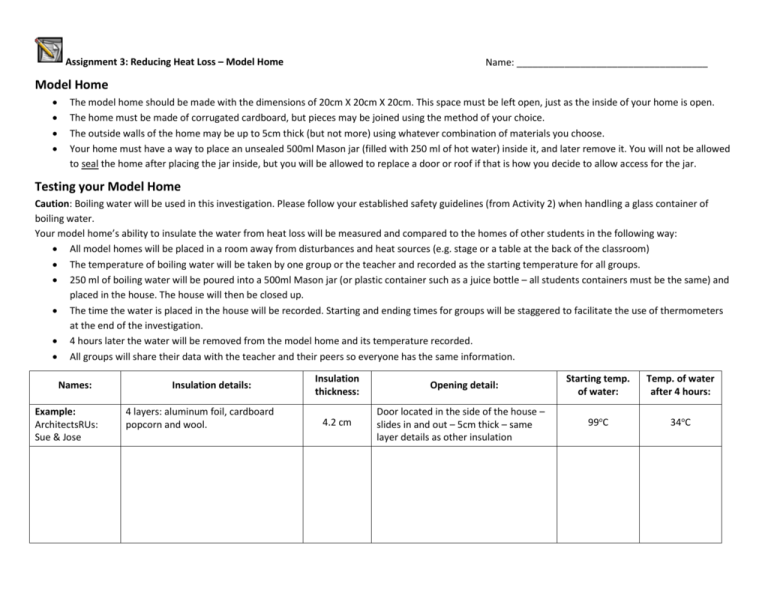Assignment 3: Reducing Heat Loss – Model Home
advertisement

Assignment 3: Reducing Heat Loss – Model Home Name: ____________________________________ Model Home The model home should be made with the dimensions of 20cm X 20cm X 20cm. This space must be left open, just as the inside of your home is open. The home must be made of corrugated cardboard, but pieces may be joined using the method of your choice. The outside walls of the home may be up to 5cm thick (but not more) using whatever combination of materials you choose. Your home must have a way to place an unsealed 500ml Mason jar (filled with 250 ml of hot water) inside it, and later remove it. You will not be allowed to seal the home after placing the jar inside, but you will be allowed to replace a door or roof if that is how you decide to allow access for the jar. Testing your Model Home Caution: Boiling water will be used in this investigation. Please follow your established safety guidelines (from Activity 2) when handling a glass container of boiling water. Your model home’s ability to insulate the water from heat loss will be measured and compared to the homes of other students in the following way: All model homes will be placed in a room away from disturbances and heat sources (e.g. stage or a table at the back of the classroom) The temperature of boiling water will be taken by one group or the teacher and recorded as the starting temperature for all groups. 250 ml of boiling water will be poured into a 500ml Mason jar (or plastic container such as a juice bottle – all students containers must be the same) and placed in the house. The house will then be closed up. The time the water is placed in the house will be recorded. Starting and ending times for groups will be staggered to facilitate the use of thermometers at the end of the investigation. 4 hours later the water will be removed from the model home and its temperature recorded. All groups will share their data with the teacher and their peers so everyone has the same information. Names: Example: ArchitectsRUs: Sue & Jose Insulation details: 4 layers: aluminum foil, cardboard popcorn and wool. Insulation thickness: 4.2 cm Opening detail: Door located in the side of the house – slides in and out – 5cm thick – same layer details as other insulation Starting temp. of water: Temp. of water after 4 hours: 99oC 34oC Assignment 3: Reducing Heat Loss – Model Home Name: ____________________________________ Class results: Complete this table as groups share their data with you: Names: Your group’s data: Insulation details: Insulation thickness: Opening detail: Starting temp. of water: Temp. of water after 4 hours: Assignment 3: Reducing Heat Loss – Model Home Name: ____________________________________ 1. Look at the insulation details for the different model homes. Which was the most effective? Why do you think it was the most effective? Which was the least effective? Why do you think it was the least effective? 2. Using what you have seen in the other homes what changes would you make to your insulation layers to decrease heat loss in your own model home? 3. Make these changes and do the experiment again. Assignment 3: Reducing Heat Loss – Model Home Name: ____________________________________ Class results Round 2: Complete this table as groups share their data with you: Names: Your group’s data: Insulation details: Insulation thickness: Opening detail: Starting temp. of water: Temp. of water after 4 hours: Assignment 3: Reducing Heat Loss – Model Home Name: ____________________________________ 4. a) How did your results change in Round 2? b) To what do you attribute this change? c) If you were to further improve your model home what would you try next time? 5. What did you notice about the class results for Round 2? 6. a) What evidence is there that groups learned from one another’s investigations? b) How does this evidence support the concept that a group of scientists working together towards a common goal will get further in their research than those same scientists working separately?











